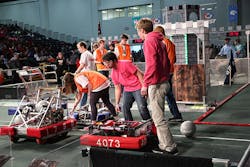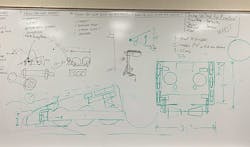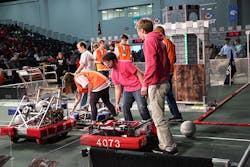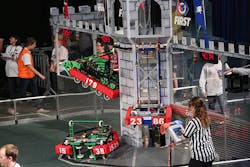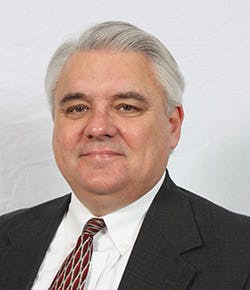The high-school robotics team had been working long nights to perfect a mechanism to launch a Frisbee through a target with frustrating results. Late one night they thought they finally had it and excitedly moved the robot to the school hallway to try a long-distance shot. The first shot floated down the long hallway and finally stopped about a hundred yards away as their cheers filled the hall! A team member ran to retrieve the Frisbee as the others made adjustments to improve the trajectory. No one had noticed the fire-safety exit sign right in the middle of the ceiling about 50 feet down the hallway. Just as their teammate passed that sign, they let loose the second shot. The sign instantly exploded into a million pieces with a loud crack, leaving nothing but dust floating in the air! The destruction was so immediate and so thorough that the team just stood there transfixed in silent awe for a moment, and then erupted in the uncontrollable whoops and laughter of hard-won success. They knew they had it!
The next morning the team coach reported the damage to the school principal. Rather than being upset she was excited, and rushed to check the security video. It was all there, the setup, the amazing shot, the vanishing EXIT sign, the cloud of dust, the stunned silence, and the cheers. She proudly shared that video with the whole school to show what the FIRST Robotic Competition had taught team 4073, the RoboKatz#.
FIRST (For Inspiration and Recognition of Science and Technology) was founded in 1992 by Dean Kamen, inventor of the Segway, with the specific goal of attracting more students to technical fields of study. Borrowing from the structure and excitement of competitive sports, he set up a competition in which teams of students build and operate robots under strict constraints. FIRST has since grown to include four programs encompassing all ages of students through high school. Over 400,000 students participated last year.
FIRST Robotics Competition is the annual program in which high-school students build robots to compete in tournament-style events. In early January, FIRST hosts the “game reveal,” in which they announce the theme and rules for that year’s competition via worldwide live stream broadcast. The game is different every year. Teams have six weeks to develop a strategy, design, build, test, and refine their robot, and practice their competition skills. The competitions begin in late February around the world, culminating in the World Championship in April.
What They Learn
Teams receive a starter kit adequate to build a basic robot that can move around under remote control, but not complete enough for it to be a strong competitor. Thus, the first of many lessons: if you want to succeed, it’s up to you to make it happen. Teams must obtain whatever they need by whatever means are available to them. Rookie teams can receive a little extra help in the form of grants.
Team members learn the basic principles of design, engineering, project management, teamwork, and project planning. In addition, the constraints placed on the teams (time, budget, robot weight, size, functions, etc.) teach them valuable lessons for life. They never have enough time, enough money, enough ideas, enough people, enough parts, material or resources, but they still have a deadline—sound familiar?
Core Values
Any good competitive program creates in its participants a culture of values, team spirit, enthusiasm, and a commitment to excellence. FIRST students also learn two basic core values: gracious professionalism and "coopertition."
With gracious professionalism, fierce competition and mutual gain are not separate notions. Gracious professionals learn and compete like crazy, but treat one another with respect and kindness in the process.
Coopertition is displaying unqualified kindness and respect in the face of fierce competition. Coopertition is founded on the concept and philosophy that teams can and should help cooperate with each other even as they compete. For example, announcements like “Team 4073 needs a pressure regulator” are very common in the pit area. Soon that team is overwhelmed with offers from competing teams. I have seen experienced teams volunteer to completely rebuild major systems of a lesser experienced team’s robot during competition. Teams are here to compete, but they are also here to help.
Other Lessons
The overall process teaches another major lesson: Life isn’t always fair. Some teams have decades of financial and community support behind them, ranks of capable mentors, their own machine tools, and a parts warehouse. Several states even recognize and support robotics as a varsity sport. Other teams have almost no resources. I know of a team that builds their robot in a classroom after school and has to move everything into a closet every night.
The First Steps
Before teams build anything, they have to analyze and compare the game’s numerous scoring methods, the related challenges, analyze their own skills, agree on a scoring strategy, brainstorm various design approaches to accomplish that strategy, and pick those that are most likely to succeed. They will likely choose to ignore some methods of scoring.
“How Are We Going To…”
Just like any engineering project, teams have to dive into the details. Teams must figure out how to use their “kit of parts” to pick up a Frisbee, reliably catch and throw an exercise ball, or navigate over uneven floors without toppling a stack of boxes the robot is carrying. The list of how-to’s for this competition can seem endless. This teaches students to prioritize and problem solve.
2013—Frisbees and pyramids
In my first year as a mentor for a robotics team, the robots had to throw Frisbees into a goal. Our team decided to launch ours by bringing the Frisbee into simultaneous contact with a spinning wheel and a stationary wall. I guided the students through the design process and calculations. First, through experimentation they determined what linear velocity they wanted. Then they calculated what the Frisbee’s rotational velocity would have to be, and finally what the size and speed of the firing wheel would have to be to produce that velocity—around 5,000 rpm.
The team used a custom-made aluminum wheel encircled with O-rings for a good grip on the Frisbee. The first time the wheel approached firing speed they got a quick and unforgettable lesson about centrifugal force as the O-rings nearly exploded off the wheel! Not surprisingly, the final solution involved good old duct tape! It required occasional replacement, but worked well enough.
In addition to Frisbee throwing ability, toward the end of the match robots had to climb a 12 ft. (3.6m) tall pyramid-shaped jungle gym. Points were awarded based on the robot’s final height. After lengthy discussions of the pros and cons of several different design approaches, and an assessment of the schedule and resources, the team decided to keep it simple. We would simply lift our robot a few inches off the floor, take those points, and forego the rest.
We would do that by engaging the lower rung of the pyramid with two stiff hooks mounted on a shaft, rotate the shaft thus lifting the robot, and end the match suspended about 1 inch above the floor. This simple action presented three engineering challenges.
First, in their initial position the lifting hooks needed clear access to the pyramid rung. After lifting, no part of the robot could be in contact with the floor. Staying level meant the hooks had to stop in a position directly over the center of gravity of the robot. Those requirements became major drivers of the frame design and placement of major components.
Second, the lifting function was driven by a small 12V motor through a planetary gear box and chain reduction. The students got a good introduction to power-train calculations and sprocket sizing.
Third, the lifting shaft had to automatically stop in its final position and stay there after power off, resisting the torque produced by the weight of the robot so that it did not drop.
If throwing Frisbees and climbing wasn’t enough, the maximum allowable weight of the robot is 120 lb. We even drilled over 1,200 holes in the covers to save weight. We knew we were very close and were collectively holding our breath at the inspector’s weighing station before competition. When the display lit up and showed 119.8, we cautiously started breathing again.
Once the competition started, the students learned firsthand about the implications of a high center of gravity. With some major drive components higher than they should have been, the robot toppled 15 seconds into the very first match when our driver applied the brakes a little too quickly. Our beautiful robot spent the rest of that match face down on the floor.
2014—Exercise Balls
My second year the robots had to pick 24-inch exercise balls off the floor, toss them over a bar to other robots, catch them, launch them through targets, while stopping opposing teams exercise balls.
Our robot had a pneumatic system including a compressor, accumulator tanks, directional valve, pressure regulator, pressure switch, over-pressure relief, cylinders, and flow controls. The students not only learned the basic principles involved, but also the function of each component and its associated problems. It was gratifying to see that look of understanding as they truly grasped the difference between force and pressure.
Our launcher consisted of a paddle powered by multiple loops of stretched surgical rubber tubing. The tubes were stretched by the action of a cam driven by a dc motor through a four-stage planetary reducer. The torque produced by that little 12V gear motor was incredible. The first time it kicked the ball all the way across the room the students’ eyes revealed a lasting educational impact.
Catching Our Own Ball
The team had worked hard for weeks to design and build a robot that could: pick up a ball, throw it through a target or over a 15-ft. bar to another robot, catch a ball, and be quick and agile to block an opponent’s ball. One student jokingly said, “Wouldn’t it be neat if we could throw the ball over the bar, then accelerate fast enough to catch that same ball on the other side?” We all had a great laugh. Two weeks later I was sent a video of our robot doing exactly that, to the background of their excited yells.
However, the robot competition is not all just geeky tech stuff. Some of our students that year showcased a particularly artistic talent, and beamed with well-deserved pride when we were presented with the “Classy Chassis Award.”
2015—Stacking Crates
Each year presents different challenges. This year robots had to build stacks of large plastic boxes, round trash bins, and foam pool noodles. Then transport those stacks to scoring platforms. Points were awarded based on the height of those stacks. Robots had to extract these items from tightly nested arrangements, and had to do all of it on a field of uneven surfaces.
That year our robot included an articulated drive system based on Mecanum wheels that enabled lateral motion (called strafing), a linear motion system, a pneumatic system, and onboard video camera for the driver.
This was a year of learning—for both the students and the mentors. Ranking near the top in two large regional competitions, we qualified to attend the World Championship.
World Championship
At the World Championship we encountered competition at a whole different level—600 teams were there! Robots were doing things we would have previously dismissed as impossible. Competition proceeded on eight separate fields simultaneously. Our winning streak came to an abrupt halt. Out of the 65 teams on our field, our ending rank was near the bottom. Surprisingly, none of our team members were disappointed. They were just flying high on the unforgettable experience, and the mentors’ eyes were opened to a whole new level of possibilities.
2016—Stronghold
For 2016, FIRST was very creative. They modeled the game around a medieval battle theme. The field included a castle tower and battlements, variable defense structures, a “secret passage,” and foam “boulders.” Points were awarded for breaching defenses, launching boulders through tower windows, and scaling the tower. To make it interesting, the selection and position of the defensive structures teams would have to face changes in every match. There were eight optional defenses including a drawbridge, a moat, and a Portcullis (a vertical sliding door with stakes). It was a rare robot that could breach all eight defenses. Most teams opted to design a robot that could breach at least two or three of the most likely defenses.
One of the challenging aspects of this game was when a team’s robot was in the firing position, the various defenses in the field almost completely blocked the driver’s view of his robot. Like many teams, we chose to mount both front and rear video cameras on our robot with displays shown on the driver’s controller screen. Many other teams were technically competent enough to design onboard video aiming systems that could automatically identify the tower windows and then position the robot and its firing system to launch the boulder. We saw the error in our decision when we learned in our first match that the on-site field communications system blocked our video signals. So we adapted our strategy to maximize our points by breaching defenses rather than firing boulders. Our heavy-duty drive system and robust construction paid off in multiple crossings of a rough terrain defense and were also major factors in our winning the Industrial Design Award.
The Bottom Line
The bottom line is to change the lives of these young students and our own society for the better. I have witnessed several versions of this story: a team member’s friend tags along with her to a work session just to see what’s going on, just to “hang out”. She is a little withdrawn and quiet. She doesn’t intend to make any commitment to a group of nerds she doesn’t really know. In fact, she doesn’t really plan on coming back at all. Then some detail of the activity gets her attention. It could be someone struggling with program code, or another one trying to assemble some complicated component, or another one being trained to safely operate a drill press. Then someone asks her to hold one end of a bar they’re cutting. As they work she asks, “What is this part for?” Thus it starts. She decides to come back the next night just to see how that part she helped to make is actually used. Within a week she has the vision and she’s bringing her own friend. At the competition they’re fully decked out in the team colors or outfits. They’re cheering for their team, and their new life-long friends. Hooked. Years into her future career she will look back on that very first night as the point where the direction of her life changed.
To find a local FRC team or event: http://www.firstinspires.org/team-event-search
To learn more about being a volunteer or mentor: http://www.firstinspires.org/ways-to-help/volunteer/event-volunteers
To learn more about FIRST programs for other ages: http://www.firstinspires.org/
To contact the author: [email protected]
Support Committee Facebook page: www.facebook.com/gstechrobotics/
